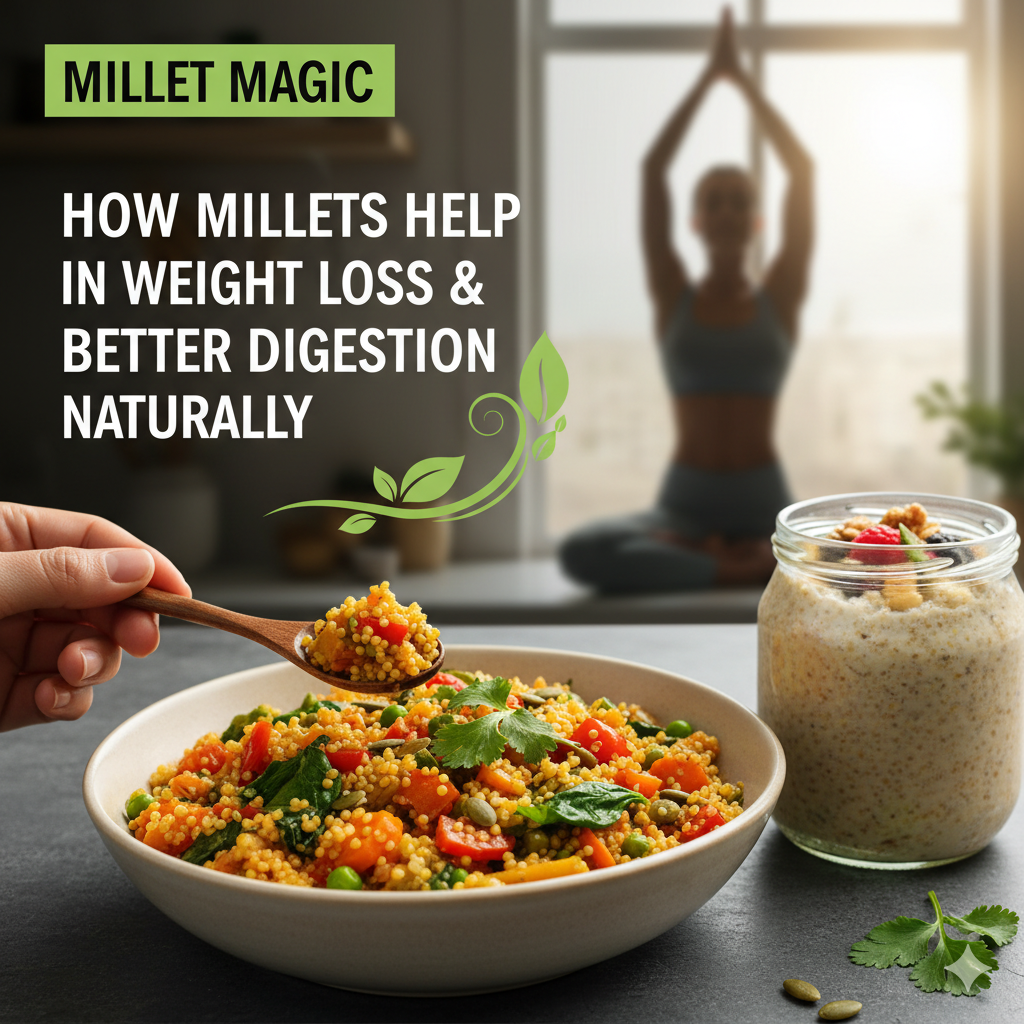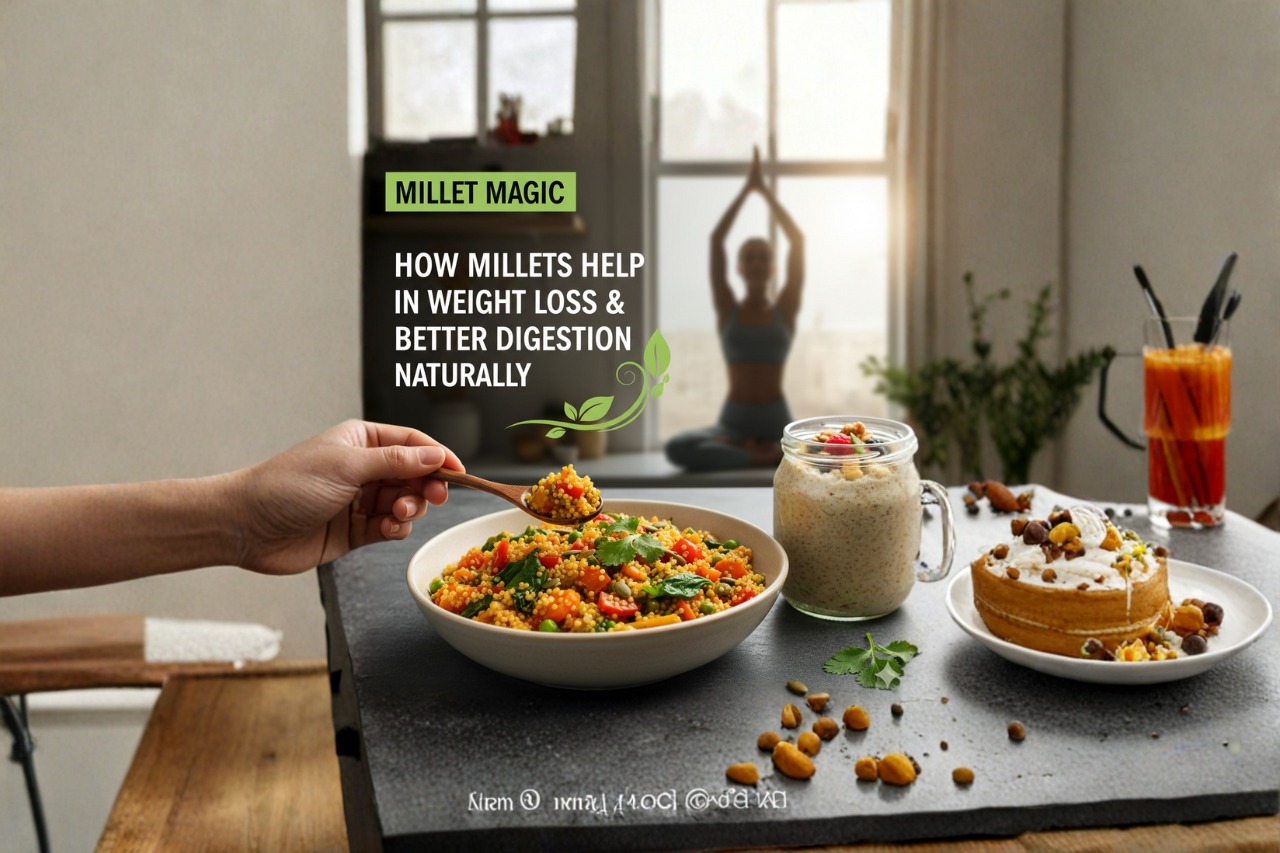If you’ve been wondering how millets help in weight loss and better digestion, you’re in for a treat. Millets are making a comeback and for good reason — they’re not just another fad, they bring real value. In this article I’ll talk about millets for weight loss, millets digestion benefits, types of millets good for gut health, and how to include millets in your diet for better digestion and leaner body. Let’s have a look, real talk style.
What are millets?
Millets refer to a group of small-seeded grasses grown as cereal crops, largely in India and Africa. These grains have been staples for centuries but kinda got sidelined when rice and wheat took over.
They include varieties like Pearl Millet (bajra), Finger Millet (ragi), Foxtail Millet, Little Millet, Barnyard Millet, and Kodo Millet.
These grains are gluten-free, nutrient dense and tend to have a lower glycemic index (GI) compared to refined grains. PubMed+3PMC+3millets.res.in+3
They provide a nice alternative if you want to improve digestion, cut down on processed carbs, and lose weight naturally.
Why consider millets for weight loss and digestion?
Here are the main reasons why integrating millets into your meals can make a difference.
1. High fibre content
Millets are rich in both soluble and insoluble dietary fibre. For example, they have about 8-15% fibre content compared to many refined grains with very low fibre. PMC+2millets.res.in+2
Fibre helps you feel full for longer (less snacking), moves things along in your gut (better digestion), and supports good gut-flora. WebMD+1
2. Lower glycemic index & steady energy
Because millets digest more slowly and release glucose gradually, they help keep your blood sugar levels more stable. That means fewer sudden hunger pangs or sugar crashes. PubMed+1
Lower blood sugar spikes often tie into better weight-control and reduced fat deposition.
3. Increased satiety (keeping you full)
Studies show that foods made with millets have the potential to increase satiety — you stay fuller for longer compared to refined grains. Frontiers
When you’re less hungry, you’re less likely to grab junk food or overeat. That helps with weight loss and digestion ease.
4. Better gut health & digestion
The fibre and the resistant starch in millets support good gut bacteria (prebiotic effect) and improve bowel regularity. WebMD+1
Good digestion equals fewer issues like bloating, constipation, and that sluggish feeling.
5. Richer nutrient profile
Millets pack more minerals (iron, magnesium, calcium, potassium) and plant-based protein than many refined cereals. millets.res.in+1
Good nutrition supports metabolism, muscle repair and overall health which indirectly helps with weight management.
6. Switch away from refined grains
One major benefit is replacing refined grains (white rice, refined flour) with whole grains like millets. That shift alone has been shown to help reduce body fat and BMI in some populations. opensciencepublications.com+1

How Millets Help in Weight Loss & Better Digestion (in practical ways)
Let’s break it down into how this works in your day-to-day.
Hunger control & fewer calories
Because you feel fuller longer you tend to eat fewer calories overall. The slower digestion in your stomach gives your brain time to register fullness. For example:
- A study found body fat mass reduced when foxtail millet was consumed for 12 weeks. PMC
- Millets reduce the “hunger index” compared with refined rice etc. Frontiers
Improved digestion and gut comfort
The bulk from fibre helps move things through your intestine. Regular bowel movements, less bloating.
The prebiotic effect of the insoluble fibre promotes healthy gut flora which is tied to metabolic health.
Balanced blood sugar & fat metabolism
When you avoid big blood sugar spikes your body stores less fat (especially around the waist). The slower release of glucose means less insulin surge and less fat-storage signal.
Better nutrient intake & metabolism boost
Millets bring in minerals that support metabolism (e.g., magnesium), help muscle repair (protein), support bone health (calcium in ragi). All this helps your body not just lose weight but do it in a healthier way.
Better digestion means better absorption of nutrients too, so you’re not just losing weight but maintaining good health.
Long-term habit & sustainability
Millets are affordable, locally available (in many regions), and can replace staples rather than being a “one-off” diet gimmick. That makes the change sustainable.
5 Types of millets especially good for weight loss & digestion
Here are some popular types along with why they stand out. Use these keywords: millet for weight loss, millets digestion benefits, etc.
• Pearl Millet (Bajra)
- High in fibre, protein, magnesium, iron and calcium.
- Low in calories compared to some other staples. Keeps you full for longer.
- Good for digestion and gut health because of the fibre.
- Keyword: pearl millet weight loss.
• Finger Millet (Ragi)
- Exceptionally rich in calcium, iron and essential amino acids.
- Low fat content, strong fibre profile.
- Keywords: finger millet digestion benefits, ragi weight loss.
• Foxtail Millet
- Low GI, high fibre, good for satiety and digestion.
- Keyword: foxtail millet weight loss, foxtail millet for gut health.
• Little Millet & Barnyard Millet
- Smaller grain size but high fibre content. Good substitution for rice/wheat.
- Keywords: little millet weight loss, barnyard millet digestion.
• Kodo Millet
- Good source of proteins and fibres, useful for weight reduction case study.
- Keyword: kodo millet weight loss.
How to include millets in your diet for better results
Okay, you’re sold on the idea, now what? Here are practical ways to bring millets into your meals.
1. Replace refined grains at meals
- Use millet instead of white rice or wheat in your lunch.
- Try millet khichdi, millet pulao, millet upma.
- For example: switch one cup of cooked white rice to one cup cooked millet.
2. Breakfast with millets
- Millet porridge with fruits and nuts.
- Millet pancakes or dosa made with millet flour.
- Example: morning breakfast of ragi dosa or millet upma.
3. Snacks and baked goods
- Use millet flour to make chapati/rotis, pancakes, muffins.
- Millet popcorn (if available) or roasted millet snack.
- Keeps you full, avoids the usual chips-snack trap.
4. Mix millets into your regular meals
- Add millet to soups, stews, salads.
- Combine with veggies, legumes for extra fibre + protein.
5. Keep portion mindful
Millets are healthy but not zero cal — eating large amounts still adds calories. Use balanced portions with veggies, lean protein.
Also drink enough water — fibre works better with hydration.
6. Step up digestion support
- Include fermented millet dishes sometimes (e.g., fermented millet idli) to enhance gut health.
- Eat with plenty of vegetables and greens.
- Move around after meals a little (a walk helps digestion).
What the science says
- One systematic review found that millet‐based foods helped lower hunger index and improve satiety.
- Another review reported that replacing refined grains with millets helped reduce BMI and body fat in some studies. opensciencepublications.com
- Case‐study: A small study with Kodo, little, foxtail, barnyard millets for 4 weeks showed average weight loss of ~1.2 kg/week and BMI reduced from 28.8 to 26.6 in a subject. austinpublishinggroup.com
- The “nutritional and therapeutic potential” paper says millets have high fibre, slowly digestible starch, resistant starch, higher essential amino acids, which supports both digestion and metabolic health.
These results are promising. But note: the studies are often small or short term. More large-scale long-term research is still needed.
Mistakes to avoid when using millets
- Switching to millet but still eating large amounts of sweets/junk — that defeats the purpose.
- Eating millet just by itself without veggies/protein — fibre works best when the rest of the diet supports it.
- Ignoring cooking method — over-cooking or using too much oil can reduce benefits.
- Not hydrating — increasing fibre without enough water can lead to constipation.
- Thinking millets can replace all healthy habits — you still need decent sleep, activity, and overall balanced diet.
Sample Meal Plan (1 day) with millets
Here’s a simple plan you can use:
- Breakfast: Foxtail millet porridge with chopped nuts, banana, a drizzle of honey.
- Mid-morning snack: A handful of roasted little millet + seeds mix.
- Lunch: Pearl millet (bajra) khichdi with mixed vegetables, side salad.
- Afternoon snack: Millet pancakes (ragi flour) with yoghurt or hummus.
- Dinner: Barnyard millet pulao with paneer/beans + stir-fried greens.
- Before bed: Warm glass of milk (or plant milk) + 1 small millet-based muffin.
Adjust portion sizes, oil, and extras depending on your calorie requirement.
Tips to increase digestion benefits
- Chew well: Your gut will thank you when you chew properly.
- Include probiotics: Combine millets with yoghurt or fermented foods.
- Move after meals: A short walk supports digestion.
- Stay hydrated: As you increase fibre, you want enough water.
- Sleep well: Digestion and metabolism both improve with good sleep.
When you will see results
You might start feeling different in a few weeks: less bloated, more regular bowel movements, fewer hunger spikes. Weight loss may follow over a few months depending on your whole diet and activity. Stick with it.
Because of the inherent fibre, slow digestion and nutrient profile, you’re giving your body better tools to lose weight and digest well.
Wrapping-up
So yeah, if you’re asking how millets help in weight loss and better digestion, the answer is they bring multiple advantages: high fibre, low GI, nutrient density, better satiety, good gut support. Used right they can be an extremely helpful part of your journey. They’re not overnight miracle grains but realistic, sustainable choices.
Make millets a regular part of your meals, pair them with veggies, lean protein, good hydration, and decent activity. Over time you’ll likely notice your gut feels better, hunger is more controlled, and those extra kilos start to slide off.
Give millets a fair shot and stick with it. Your digestion will thank you, your body will respond, and your weight loss efforts will get a natural climb upward.
Common questions (FAQ)
Q: Will switching to millets guarantee weight loss?
Nope. Switching to millets helps if you also maintain calorie balance, remain active, and avoid overeating. It’s a strong tool but not a magic bullet. Some research shows BMI reductions when millets were part of diet.
Q: Can everyone eat millets? Are there side-effects?
Mostly yes, millets are safe and gluten-free so good for many. But if you have thyroid issues, note that certain millets (like pearl millet) may contain compounds that interfere with iodine absorption — so check with your doctor.
Also, sudden increase of fibre can cause gas/bloating; ramp up slowly and drink water.
Q: How much millet should I eat?
There’s no one size fits all. But replacing 1-2 meals a day with millet instead of rice/wheat is a practical start. Portion sizes depend on your calorie needs and activity. Use millets as part of whole balanced diet.
Q: Does millet taste good? Will I get bored?
Millets have a mild nutty flavour and you can cook them many ways. You won’t be stuck with boring meals if you vary the recipe — treat them like a new base grain. Remember: changing diet does take some adjustment but you’ll get the hang.

